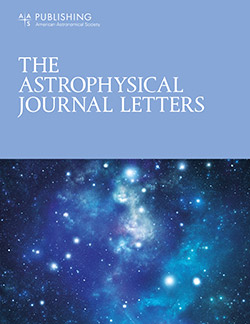从银道面分解TeV-PeV发射的起源:多信使观测的意义
IF 8.8
1区 物理与天体物理
Q1 ASTRONOMY & ASTROPHYSICS
引用次数: 0
摘要
从银河面观测到高能中微子和γ射线发射,它们可能来自单个源和/或漫射宇宙射线。我们通过中微子和γ射线在强子相互作用中的多信使连接来评估这两个成分的贡献。我们利用4FGL、HGPS、3HWC和1LHAASO等γ射线目录,以及西藏AS γ和LHAASO对银河系漫射辐射的测量,推导出了银河面中微子发射的最大通量。我们发现,当排除脉冲星、脉冲星风星云和TeV晕等有希望的轻子源时,冰立方星系的中微子通量大于所有已分解源的贡献。我们的结果表明,银河系中微子发射很可能是由宇宙射线海和未解析强子γ射线源的漫射发射主导的。此外,冰立方的通量与非脉冲星源的通量和LHAASO漫射辐射的总和相当,特别是在~ 30 TeV以上。这意味着LHAASO散射发射可能主要来源于强子相互作用,要么是真正的散射发射,要么是未解析的强子发射。未来需要在南半球进行中微子望远镜观测和空气簇射γ射线实验,以准确地解开银河系的源和漫射辐射。本文章由计算机程序翻译,如有差异,请以英文原文为准。
Decomposing the Origin of TeV–PeV Emission from the Galactic Plane: Implications of Multimessenger Observations
High-energy neutrino and γ-ray emission has been observed from the Galactic plane, which may come from individual sources and/or diffuse cosmic rays. We evaluate the contribution of these two components through the multimessenger connection between neutrinos and γ-rays in hadronic interactions. We derive maximum fluxes of neutrino emission from the Galactic plane using γ-ray catalogs, including 4FGL, HGPS, 3HWC, and 1LHAASO, and measurements of the Galactic diffuse emission by Tibet ASγ and LHAASO. We find that the IceCube Galactic neutrino flux is larger than the contribution from all resolved sources when excluding promising leptonic sources such as pulsars, pulsar wind nebulae, and TeV halos. Our result indicates that the Galactic neutrino emission is likely dominated by the diffuse emission by the cosmic-ray sea and unresolved hadronic γ-ray sources. In addition, the IceCube flux is comparable to the sum of the flux of nonpulsar sources and the LHAASO diffuse emission especially above ∼30 TeV. This implies that the LHAASO diffuse emission may dominantly originate from hadronic interactions, either as the truly diffuse emission or unresolved hadronic emitters. Future observations of neutrino telescopes and air-shower γ-ray experiments in the Southern hemisphere are needed to accurately disentangle the source and diffuse emission of the Milky Way.
求助全文
通过发布文献求助,成功后即可免费获取论文全文。
去求助
来源期刊

Astrophysical Journal Letters
ASTRONOMY & ASTROPHYSICS-
CiteScore
14.10
自引率
6.30%
发文量
513
审稿时长
2-3 weeks
期刊介绍:
The Astrophysical Journal Letters (ApJL) is widely regarded as the foremost journal for swiftly disseminating groundbreaking astronomical research. It focuses on concise reports that highlight pivotal advancements in the field of astrophysics. By prioritizing timeliness and the generation of immediate interest among researchers, ApJL showcases articles featuring novel discoveries and critical findings that have a profound effect on the scientific community. Moreover, ApJL ensures that published articles are comprehensive in their scope, presenting context that can be readily comprehensible to scientists who may not possess expertise in the specific disciplines covered.
 求助内容:
求助内容: 应助结果提醒方式:
应助结果提醒方式:


